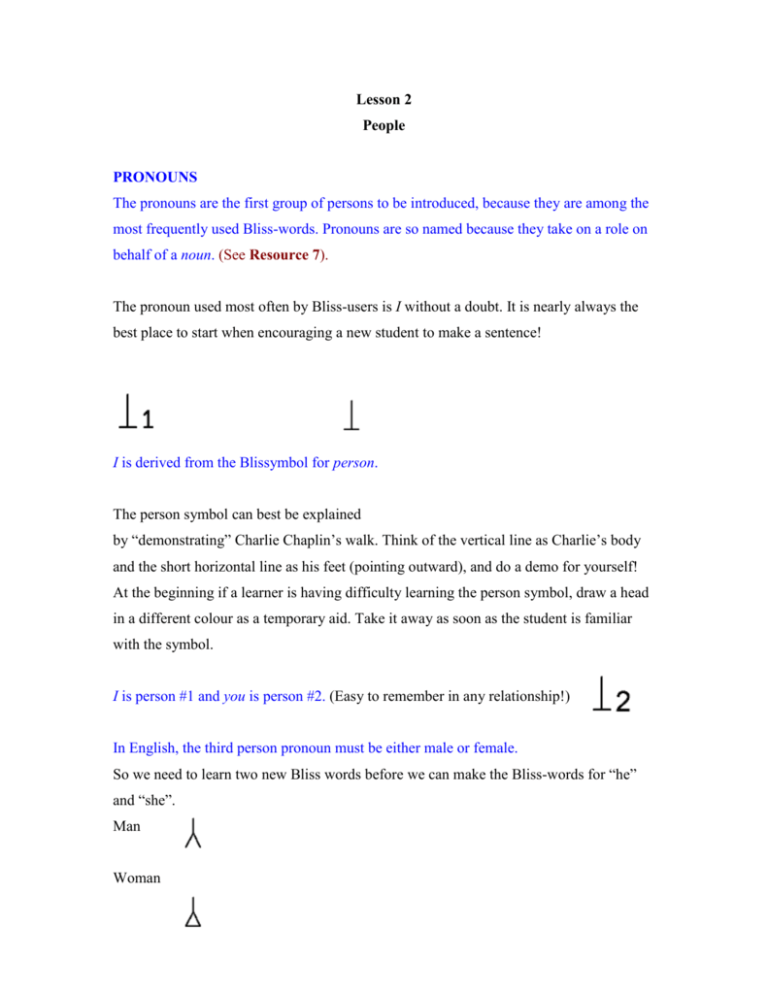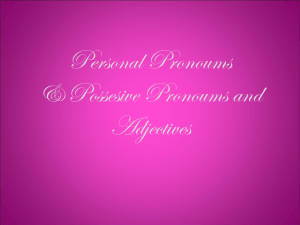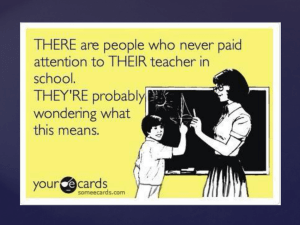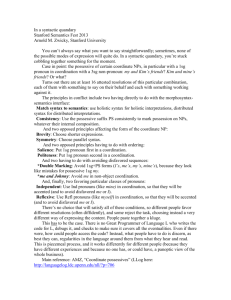Lesson_2 - Blissymbolics
advertisement

Lesson 2 People PRONOUNS The pronouns are the first group of persons to be introduced, because they are among the most frequently used Bliss-words. Pronouns are so named because they take on a role on behalf of a noun. (See Resource 7). The pronoun used most often by Bliss-users is I without a doubt. It is nearly always the best place to start when encouraging a new student to make a sentence! I is derived from the Blissymbol for person. The person symbol can best be explained by “demonstrating” Charlie Chaplin’s walk. Think of the vertical line as Charlie’s body and the short horizontal line as his feet (pointing outward), and do a demo for yourself! At the beginning if a learner is having difficulty learning the person symbol, draw a head in a different colour as a temporary aid. Take it away as soon as the student is familiar with the symbol. I is person #1 and you is person #2. (Easy to remember in any relationship!) In English, the third person pronoun must be either male or female. So we need to learn two new Bliss words before we can make the Bliss-words for “he” and “she”. Man Woman The man can be explained by pointing to his legs and noting that he is wearing trousers, whereas the woman is wearing a skirt. Mr. Bliss has another explanation for these two symbols, which can be discovered by going to Resource 14. We can now use these symbols to arrive at the third person pronouns singular. He She A good way to remember these pronoun numbers is this rhyme “I am 1, and you are 2, and he and she are 3!” And now a pronoun that does not require a number, as it does not refer to a person, but rather refers to a thing or sometimes to an animal. The Bliss-word is it. C.K. Bliss says this symbol is derived from little. (See later in this lesson – big and little.) The symbol also looks like the top part of the symbols for man and woman minus the specific gender parts. Next we need the plural pronouns, so we look to Bliss’ way of arriving at the plural. Mr. Bliss enjoyed identifying the relationships between meanings. He arrived at the plural indicator by noting its relationship to the meaning of the root symbol for much/many and to the symbol for multiplication. He then used different sizes of the symbol to specify each distinct meaning. Multiplication (large size X, positioned on the earth line) Much/many (small size x, positioned on the earth line) Plural indicator (Mini size of x positioned on the indicator line) Indicator Line…………………………………………………………………… Skyline ………………………………………………………………………….. Midline …………………………………………………………………………. Earthline ………………………………………………………………………… It is important to note at this time that the plural indicator is positioned on the same line as the thing indicator. All the indicators will be located over the Bliss-word they are modifying and they will usually be positioned over the first Bliss-character in the Blissword. There are, however, some exceptions and they can be found in Resource 15. Now we are ready for the plural pronouns. We You (when referring to more than one person) They There are many more pronouns and they can be found in Resource13. At this stage of your learning, the most important additional pronoun to remember is me. Both I and me need to be included on your display. me to I “Me is formed from superimposing the Blissymbol for to over the Blissymbol for I. To remember, think of the pronoun you need to use for the first person, when it follows “to”, e.g., Give the book to me. Now that you know the plural form of the first person, you will not be surprised to learn that the Bliss-word for us is Think “Give the books to us” Possessive Here is a bit more grammar so that you can do more things with pronouns. It is important for Bliss users to be able to express ownership or possession. You might want to be able to say “my” and “your” For example, to describe a hand as “my hand” and your hand” or “his hand” and “her hand”, you need the Bliss-character for the “possessive”. Here it is: . It is located on the earth line and when written the possessive is always placed as the last Bliss-character in a Bliss-word. When pointing to Bliss-words on a display, it is usually added after a Bliss-word is indicated, to tell the conversation partner that the preceding word is to be considered “possessive”. It is derived from the Bliss-word for possession or ownership which is explained through the two Bliss characters, addition and earth. Mr. Bliss describes the meaning thus: “an addition, a gain, a plus of some very earthly (material) thing.” In addition and possession, the plus Bliss-character is large size. In the possessive Blisscharacter, the size is small size. In the Bliss-word for earth, we say the line is full length. There will be other Bliss-words in which the line is full length and some in which they are half-length. Here is my and your for inclusion on your display. It is also important be able to state that something is “mine”, or “yours”. For your display, you will only have available “my”, “mine”, “your”, ”yours”. Because of space limitations, you will have to choose the one(s) you wish to have. There is not room for them all. The other possessive pronouns, e.g., his, hers, ours, theirs, etc. appear in the pronoun chart in Resource 13 Have you noticed a new indicator that has appeared in the Bliss-words for my and your? This is called the description indicator and is used to mark adjectives. When we get to Lesson 5, you will find out why the description indicator has the shape it does. For now, just remember it is located on the indicator line just like the plural and thing indicators, and it is used when a Bliss-word is describing some thing or person. Note: The distinction between my and mine has not been made in the BCI Authorized Vocabulary, to date. When communicating face-to-face, the distinction is not needed, as the partner will say the appropriate word in context. For voice output usage, however, the two distinct Bliss-words are needed. For synthetic speech, the descriptive indicator can be used when the word is being used as a possessive adjective that will be followed by another word which it describes. e.g., my book. When one is saying “The book is mine”, no descriptive indicator is needed. Mine, as a possessive pronoun, can stand alone. If you have mine on your display, and you wish to designate that the word intended is my, the description indicator can be pointed to prior to pointing to mine, to signal the possessive adjective. The distinction between my and mine is not needed by an early Bliss user. It is of interest however, to know that the distinction can be taught as the user’s language abilities develop. We’ve tackled the pronouns first among the people Bliss-words, because there is so much to learn that can be applied to other Bliss-words. Be watching for the possessive, plural, different size symbols with the same shape, and the use of numbers within Blisswords, as you learn new vocabulary. Family Members Now it’s time to move to some other people Bliss-words. We’ll look at the family members. If you gained new insights in learning the pronouns, just wait until you get to your extended family Bliss-words! We’ll start with some easy family Bliss-words. Mother: “The woman who protects.” The protection symbol is derived From the roof of the house Bliss-word. We’ll show it here. You will see it again when the nouns for places are introduced. And here are the Bliss-words for protection and roof. (Just to remind you of what happens when you add the thing indicator!) Now, back to Father ”The man who protects” Sister “The female who is protected who is number 2!” Brother ”The male who is protected Who is number 2!” To learn brother and sister, begin by thinking who is number 1 in the family, and it will be easy to give your brother and sister number 2! This is a very easy concept to teach to Bliss learners! They have no problem in remembering who is number 1 and, by default, who becomes number 2! You now need a way to remember the Bliss-words for son and daughter. We always hope there will be no #1 or #2 in the eyes of parents. So think of the Bliss-words for son and daughter as being the same as the symbols for brother and sister but without any number! Son Daughter There is another way to remember son and daughter. Daughter is the female child in a family who is protected by the parents. Son is the male child in a family who is protected by the parents. This illustrates another feature of Blissymbolics. You can explain the composition of a Bliss-word in the way that is most memorable to you or to the person you are teaching. The important thing is that the explanation is meaningful and memorable. Although they will not be available for your display within this course, I would like to show you parent, grandmother and grandfather at this time, because they have a very important principle to demonstrate. In the Bliss-words for mother and father, the gender of the person who protects is shown through the skirt shape and the trouser shape within the symbol. In the Bliss-word for parent, the person symbol is used with the protection symbol to denote the general meaning to include both mother and father. In the Bliss-words for grandmother and grandfather, it is very important to order the components properly. The ‘spellings” are explained: “mother of a parent” and “father of a parent”. The Bliss-character that begins the Bliss-word tells you “what kind of person it is. First it is a mother and secondly it is a mother of a parent. Similarly with Grandfather, first it is a father and secondly it is a father of a parent. You can find out about many more family members in Resource 16. Community Members You will see the importance of the first character in Bliss-words in the next set of people you learn. Always keep in mind, the first character usually tells you the most important piece of information and tells you what kind of a person or thing the Bliss-word denotes. The two Bliss-words for community members that will be available to you in creating your display are: Teacher Doctor As you will see, both teacher and doctor begin with the person Bliss-character. As previously pointed out, the first character tells you what kind of thing this Bliss-word represents. It is a kind of a person. The Bliss-characters that follow describe the person. The teacher is the person who gives knowledge. The doctor is the person of medicine. The Bliss-characters within these two Bliss-words are: To teach “giving” - make a container of your hand and then pretend to give something you are holding in that container to your partner, using an upward motion as depicted by the upward arrow. To teach “knowledge” - you need to refer to two Bliss-characters- house and mind. Mr. Bliss explains knowledge as the “store house of the mind” and he replaces the roof of the house symbol by the mind symbol. Now you can explain the “spelling” of teacher. The person who gives that which is stored in the mind (knowledge). The Bliss-word for medical is derived from a modified shape of caduceus, the traditional medical symbol. In classical mythology, the symbol for the messenger of the gods and the son of Zeus - Hermes (Greek) or Mercury (Roman) - was a winged staff entwined with two serpents. Mr. Bliss refers to it as the “rod of Aesculapius”. There are many community members illustrated in Resource 17. As further examples of the classifier coming first, here are three of them. Can you identify which is the fire fighter (person + destroy + fire)? Which is the letter carrier (person + letter)? Which is the police officer (person + protection)? If you chose the middle Bliss-word as fire fighter, the last Bliss-word as letter carrier, and the first Bliss-word as police officer, you were correct. You also had to identify the shape as the envelope as a “letter”, the right-leaning diagonal as “destroy”and the vertical curved line as “fire”. Fire will be available to you for your display and will be presented again when we come to the Lesson 8 (Nouns). You will hear about destroy again as well. People by Age Group The next Bliss-words demonstrate the symbol age groups there are to be found within the language of Blissymbolics. It is always fun to discover them. To understand the composition of the age group Bliss-words, you need to know the following Bliss-characters: Flower Big Little Through these three Blissymbols being superimposed on each other in different ways, we arrive at the Bliss-words for: Baby Child Teen-ager Adult Can you see how the following explanations apply? Baby – the child who is not yet able to stand up independently and hence is shown lying down. Child – little flower Adult – big flower Teenager – fluctuating between being a child and being an adult. And lastly, now that you know the flower symbol, you can combine the head of the flower with the “trousers” and “skirt” as in man and woman, and you have the Blisswords for boy and girl. You will be able to select any or all of the above Bliss-words for your display. As we enter Lesson 3, we will begin thinking about the design of the display you will be making and soon, with one more lesson, you will be making sentences.








